What are self-tapping screws and what they are
Screws, screws, bolts - these types of fasteners have been used for a long time, but there are also self-tapping screws. What is it and what are their features? What types of screws are there, how to choose them?
The content of the article
- 1 How does a self-tapping screw differ from a screw
- 2 Types of self-tapping screws
- 3 The choice of the length of the screws
- 4 Diameters and lengths of self-tapping screws with countersunk head GOST 1145-80 and semi-countersunk head GOST 1146-80
- 5 Lengths and diameters of self-tapping screws with a semicircular head according to GOST 1144-80
- 6 How to choose wood screws
- 7 The choice of screws for metal
- 8 Length and diameter of different types of roofing screws
How does a self-tapping screw differ from a screw
Let's start with the definitions. A screw is a fastener with an external thread applied to the rod. When joining parts, the external thread of the screw aligns with the internal thread on the hole in the part or parts. So for the installation of the screw, you need to drill a hole in advance. A screw differs from a screw in that it has a smooth taper at the end and more rare threads.
Now attention. Self-tapping screw is short for self-tapping screw. It differs in that it does not require a pre-drilled hole for installation. When screwing in, it cuts the required grooves by itself. Hence the term - self-tapping. And so that the self-tapping screw can itself "bite" into the material, its thread is triangular, with sharp edges and, as a rule, deeper. So, a self-tapping screw is a type of screw that itself drills a hole in the material as it is screwed in.
If we talk about the difference between self-tapping screws and screws, then the self-tapping screw has a more elongated and sharp edge. With this shape, it is easier to "bite" into the material. To install self-tapping screws, a screwdriver is usually used, which allows you to do a large amount of work, in contrast to using a conventional screwdriver. Overcoming material resistance when cutting a hole is not easy.
Types of self-tapping screws
Divide the self-tapping screws according to the area of application. They are universal, for wood, metal. These are three main and large groups. There are even more highly specialized ones - for concrete, drywall (GKL) and gypsum fiber sheets (GVL)... There are separate groups for window profiles and roofing materials.
However, keep in mind that if we talk about self-tapping screws for metal, we mean sheet metal or profiles from it. And then, in sheets of large thickness, holes are often pre-drilled. It is easier and faster to install fasteners, especially if it does not shine with quality.
Moreover, holes are often drilled in wood for self-tapping screws. In dense wood - such as oak - this is an almost immutable rule. The density of such wood is high and otherwise the process is too slow. In soft wood, holes for the installation of self-tapping screws are drilled for another reason - so that the tree does not crack. When self-tapping screws are placed almost on the edge, this is possible. So they are insured. In any case, the diameter of the hole for installing the self-tapping screw should be 1-2 mm less than the diameter of the fastener. Only under this condition it will be easy to install, and the strength of the connection will be normal.
There are also universal screws. But this does not mean that they are "for everything." This means that they are optimal when it is necessary to combine wood and metal. And for metal-to-metal, wood-to-wood connections - it is better to take your own narrow-profile fasteners.
For wood and metal - the difference
What is the difference between self-tapping screws for wood and metal? First of all, with different thread pitch. For installation in wood, the carving is rarer. This is quite enough for anchoring in the fibrous structure. A self-tapping screw for metal has tighter threads. Another difference is in the metal used for the manufacture of fasteners.
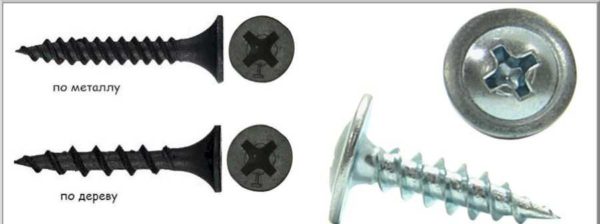
What is the difference between wood and metal screws. The first thing that catches your eye is the thread density. The second is the diameter of the pin, the third is the height of the thread profile
Self-tapping screws for metal can also have not just a narrowing with an applied thread, but additional planes - a drill. These fasteners can drill holes in sheet metal up to 5 mm thick. So that the edge of the self-tapping screw does not slide over the surface of the metal (and the wood too), the installation point is "screwed". A small dent is left with a punch and hammer. It is not at all necessary to break through the metal. It is enough that the self-tapping screw goes down into the recess.
Metal and processing method
Self-tapping screws are made from carbon steel, stainless steel and brass. In the overwhelming majority of cases, we use carbon steel screws. They are not as expensive as stainless steel, but quite durable if you choose the right one. However, steel screws can be of different colors: white, yellow and black. They receive color after processing. Black ones are obtained by oxidation and phosphating, yellow ones - by anodizing, and white ones are usually galvanized. There are also yellow galvanized ones.
What color of self-tapping screws is better to choose? It depends on what material. If for wood, the best choice is anodized. They are yellow. Yes, they are much more expensive than black ones. But black oxidized ones rust and sweat leaves on the wood. For metal, this is not critical, since usually the joints are painted over so that they do not rust. But there is still such a moment: black oxidized self-tapping screws can be brittle. If you "twist" it during installation, the head may fly off. Not only can this happen during installation, it also happens under load. For example, when the flooring was screwed to the joists with black oxidized self-tapping screws. Boards are known to bend and dry out. And this leads to increased loads on the fasteners. And the caps of the black screws often fly off. This can be seen when rebuilding the floor. And also due to the fact that some boards begin to bend or sway and squeak more strongly. The hats have broken off and the fasteners do not hold.
To install metal sheet material, it makes sense to take galvanized self-tapping screws. There will be no conflict between coatings and chemical reactions. In this case, they usually take whites. Yellow ones are used for aesthetic reasons - when installing door hinges, locks, handles and other similar hardware in yellow.
Types of self-tapping screws: head and slot
Self-tapping screws are also divided by head type. There are many types, but it is worth remembering that there are hidden, semi-hidden and protruding (hemispherical, semi-cylindrical, etc.). Also available with hex heads. They are used for installing roofing material, polycarbonate, fastening materials to fences, sheathing frames. In general, where rigid fixation is important. It is self-tapping screws with hex heads that are usually equipped with sealing washers with rubber gaskets.
Self-tapping screws with countersunk heads are hidden in the wood during installation. In this case, it is not necessary to pre-drill holes with a larger diameter for the cap. To fit the hat “like clockwork”, take countersunk heads with notches.
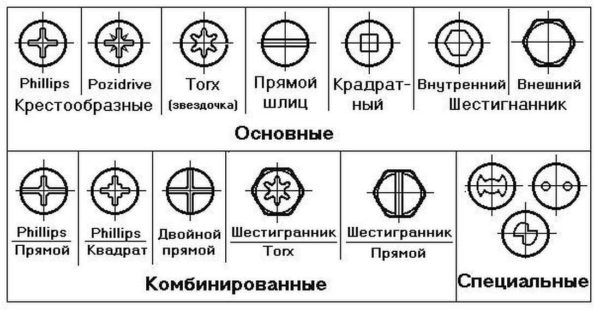
Types of slots on self-tapping screws. It makes sense to take those for which you have an instrument
The caps have a recess for the tool - this is the slot. This parameter is selected based on the available tool or bit. You can buy them - bits - of course, but you should think about it in advance. And then acquire fasteners and bits.If we talk about which spline is better, then at the moment it is considered the best Torx (torx), since it transmits the best torque. This is important when working with tough material.
The choice of the length of the screws
To choose the length of the screw, there are several rules that apply in different situations. When joining / joining two not very massive parts, the following selection rules work:
- So that you do not connect, the sharp end of the self-tapping screw should not stick out from the other side of the parts to be connected. That is, in any case, it should be shorter than the parts to be joined. Moreover, it is believed that the maximum strength will be if at least 5-6 mm remains to the edge of the lower part. So count it.
- On the other hand, the minimum self-tapping screw should fit into the bottom part by at least 1/3 of the thickness of the part to be attached. That is, if you fasten, say, a beam of 100 * 100 mm, then the minimum length of the self-tapping screw should be 1/3 longer. For this timber, the minimum screw length is 100 + 100/3 = 133 mm. Take the nearest larger. If you fasten a board 28 mm thick, then the minimum screw length is 28 + 28/3 = 37 mm (usually 42 mm is chosen).
If a thin piece is attached to a massive base, another rule works. Then the length of the fastener should be 2-2.5 times longer than the attached part. So it is necessary to select the length of the self-tapping screw, if you attach something to a wall, say, or to a concrete floor. In this case, to fix the same 28 mm board to the wall, the length of the fastener is 56-70 mm. This is the difference.
Screw sizes: the most applicable options
How to choose the length of the self-tapping screws should be clear. Now about what they are in general. The situation here is confusing. Neither screws nor self-tapping screws have a common standard. There are several standards of "worn out" years of release, in which the sizes of some types of self-tapping screws are prescribed.
- GOST 1145-80. Countersunk self-tapping screws.
- GOST 1144-80. Round head screws.
- GOST 1146-80. Half-countersunk head screws.
The situation today is that each manufacturer produces its own "line". They are oriented, of course, on demand. Well, the parameters of the heads are usually made in accordance with one or another GOST. This will somehow stabilize the situation. Sometimes the assortment - diameters and lengths are also made according to the standard. In this case, in the description of self-tapping screws, the diameters in which they are generally produced are indicated, and then there is a postscript: it corresponds to such and such a GOST. This means that the heads comply with the specified standard, as well as that the assortment corresponds.
Diameters and lengths of self-tapping screws with countersunk head GOST 1145-80 and semi-countersunk head GOST 1146-80
| Self-tapping screw diameter, mm | Screw length, mm | Self-tapping screw diameter, mm | Screw length, mm |
|---|---|---|---|
| 1,6 | 7, 10, 13 | 4,0 | 13, 16, (18), 20, (22), 25, 30, 35, 40, 45, 50, 60 |
| 2,0 | 7, 10, 13, 16 | 5,0 | 13, 16, (18), 20, (22), 25, 30, 35, 40, 45, 50, 60, 70 |
| 2,5 | 7, 10, 13, 16, (18), 20, (22), 25, | 6,0 | (18), 20, (22), 25, 30, 35, 40, 45, 50, 60, 70, 80, 90, 100 |
| 3,0 | 10, 13, 16, (18), 20, (22), 25, 30 | 8,0 | 50, 60, 70, 80, 90, 100 |
| 3,5 | 10, 13, 16, (18), 20, (22), 25, 30, 35, 40 | 10,0 | 80, 90, 100 |
How, then, are self-tapping screws chosen in terms of length and diameter? Calculate / determine the length that is needed, determined with the type of head. Then they look at the diameters and make the final choice. Let's say right away that the principle “thicker is better” does not work for wood. This can be applied to metal. For wood, thinner, but with good carvings and good metal are better. This is ideal.
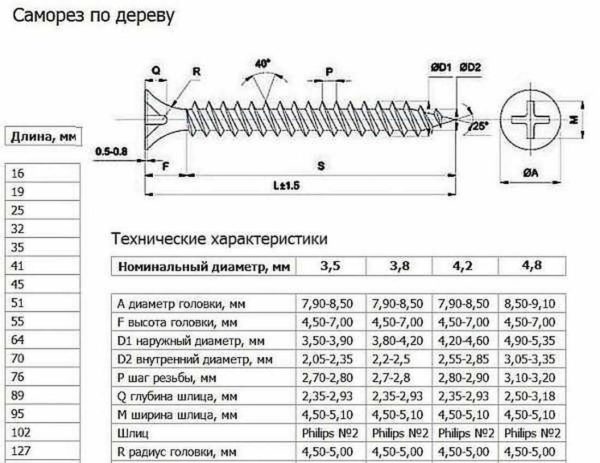
If the manufacturer has his own parameters of self-tapping screws, they are indicated in the description
But this is not enough. The store usually offers up to a dozen options of the same size, but from different manufacturers. And if it is more or less easy to decide on the metal and the type of processing, then it is difficult to choose which brand to take. There are, of course, proven ones, but they are expensive. Although, if you take cheap ones, 30-50% can go to marriage. What kind of marriage? Now they bend, then the caps fly off. It is not always, but often. If you are "lucky" to run into such fasteners, it turns out that buying "expensive" ones would not be more expensive. Well, or not much more.
Lengths and diameters of self-tapping screws with a semicircular head according to GOST 1144-80
| Self-tapping screw diameter, mm | Bar length in mm | Self-tapping screw diameter, mm | Bar length in mm |
|---|---|---|---|
| 1,6 | 7, 10, 13 | 4,0 | 13, 16, (18), 20, (22), 25, 30, 35, 40, 45, 50, 60 |
| 2,0 | 7, 10, 13, 16 | 5,0 | 13, 16, (18), 20, (22), 25, 30, 35, 40, 45, 50, 60, 70 |
| 2,5 | 7, 10, 13, 16, (18), 20, (22), 25 | 6,0 | (18), 20, (22), 25, 30, 35, 40, 45, 50, 60, 70, 80, 90, 100 |
| 3,0 | 10, 13, 16, (18), 20, (22), 25, 30 | 8,0 | 50, 60, 70, 80, 90, 100 |
| 3,5 | 10, 13, 16, (18), 20, (22), 25, 30, 35, 40 | 10,0 | 80, 90, 100 |
Now compare the two tables. They are compiled according to different GOSTs.As you can see, the diameters and lengths are the same. This makes life easier. If in the production of fasteners they adhered to the standard in terms of the diameter / length ratio, then everything is simple. If not, then the manufacturer in the description of the screws attaches a table with dimensions (as in the picture above).
How to choose wood screws
You should not use metal screws or universal screws for fixing wood. Universal ones are good when you need to twist wood and metal. And when twisting two pieces of wood, they work worse. In the sense that specialized fasteners will hold the wood better. That is, we consider only wood screws. Believe me, there will be plenty to choose from.
As already said, wood screws have a rarer thread with a higher profile (the grooves between the threads are deeper). They are used not only for wood, but also for all types of sheet materials: gypsum fiber board, plywood, OSB (OSB), fiberboard and chipboard. Now about which ones work better.
Thread and other "bells and whistles"
First you need to choose the type of hat. Secret or with a press washer, cylindrical, hemispherical - select based on what kind of connection you need to make. It is also recommended to choose a spline of the TORX type, since it best transfers the torque from the power tool. Further in order.
- It is necessary to determine whether the thread should be applied to the entire rod or not. If you need to fasten two pieces of wood and pull them tightly together, take a self-tapping screw with an incomplete thread. This means that there must be an unthreaded area under the head. The length is equal to the thickness of the attached part or slightly more. Due to this zone, one part is "attracted" to another.
- To make it easier to screw into hard rocks or sheet material, there are wood screws with a router or mill. The cutter is only available on self-tapping screws with an incomplete thread. It looks like a few screw-type notches that were applied before starting the thread. The notches soften the wood, after which the self-tapping screw "goes" better.
- In general, wood screws have a thinner point and thus prevent wood from cracking. But there are also special "lotions" against cracking. It can be:
- grooves;
- cutting edges in the form of notches on the screw body;
- notches on several lower threads.
Are these bells and whistles necessary or is it wasted money? Incomplete threads are not news. One detail "sits" on top of another much denser. Try the rest. Only from your own experience you will understand whether it works or not, and what exactly suits you best.
And practical advice on choosing wood screws. It is important that the thread runs straight from the tip. If the first turn is too far or the tip is blunt, do not take it. There will be continuous torment, not work.
The choice of screws for metal
The types of self-tapping screws for metal are more numerous, so disassemble and disassemble. They are definitely not made of brass - the metal is too soft. Self-tapping screws for metal are made from carbon and stainless steel. All types of heads are present, the slots are also almost all available. There are two types of tips - with a sharp end and a drill. They are also divided according to the field of application - for indoor and outdoor use. They differ in the thickness of the protective layer. For outdoor use, the coverage should be thicker. Consider the most common types of self-tapping screws for metal.
Self-tapping screws with a press washer (seeds)
They differ in the head - it is wide and flat. A roller is formed along its edge, which presses the parts. This type of hardware is used not only for fastening sheet metal and products from it (for example, a frame for drywall is assembled). It can also be used if you need to fix plastic, plywood or fiberboard to wooden bars, metal or wooden frame.The flat and wide head holds the materials well at the junction.
If you look closely at the head of the fastener in the photo on the right, you will see that the part has a rounded and almost flat shape. By the way, there are most of them in stores and on the market. But this is not the best option for this fastener, although it is cheap. There are very few decent products of this kind. Often the spline is shallow, untreated metal that breaks or bends. But the most important thing is that even white galvanized self-tapping screws have a very thin galvanized layer - 3 microns. It quickly collapses and the metal begins to rust.
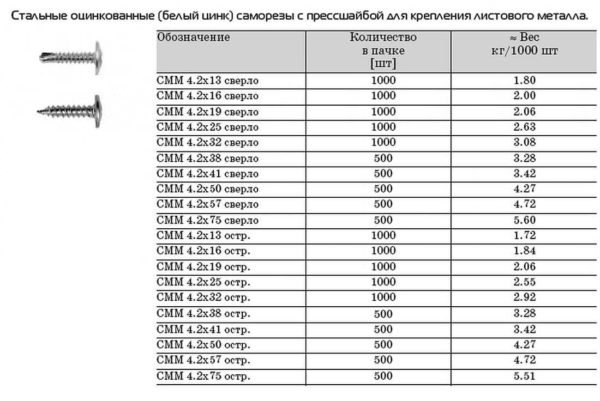
Self-tapping screws with a press washer are produced only in one diameter - 4.2 mm, but the length can be different
If you look at the more expensive metal screws with a press washer (in the photo on the left), they have a trapezoidal head. It is higher, which allows you to make a deeper slot. They are also called "reinforced". The quality of such fasteners is much higher. A deeper spline results in better torque transmission. This makes it possible to tighten the parts even without increasing the size of the screw. By what means? Due to the fact that the reinforced structure can withstand more torque.
The sizes of metal screws with a press washer are not encouraging. Usually there is only 4.2mm diameter, and length can be 13, 16, 19, 25, 32, 38, 41, 50, 57, 75mm. Package weight depends on the number of pieces. It can also be one of the quality assessment criteria. In any case, the density of the metal and how accurate the dimensions are. Because very often the rod is not made 4.2 mm, but 3.8-4.0 m, also in length. And the thickness of the cap is less. In general, pay attention to the weight of the screws.
Self-tapping screws for GKL profiles
These are small black hardware. The sizes do not indulge in variety. There is one diameter - 3.5 mm and two possible lengths - 9.5 and 11 mm. For their small size they are called "bugs". They are made of zinc-coated or phosphated steel. The head is a truncated cone, the slot is cruciform. A notch can be made on the underside of the head. It serves for braking - it starts to cling to the relief on the self-tapping screw, which turns off the rotation of the screwdriver.
There is a pointed screw, there is a screw. Despite their small size, they drill metal up to 0.9 mm thick, and fasteners with a drill - up to 2.0 mm. But this is if they are of normal quality. Please note that this hardware is designed for indoor use. It will rust quickly outside, so don't use it outside.
Black self-tapping screws for attaching the gypsum board to the frame
The drywall frame is assembled using "bugs" or self-tapping screws with press washers. The sheets themselves are attached to the frame using black countersunk head screws with a sharp end. They are made of phosphated steel, there are also galvanized ones. Actually, these are self-tapping screws for wood or metal. What to take to attach the gypsum board? Depends on which frame was assembled. For wooden blocks, take on wood, for profiles - on metal.
If you're plastering a regular living space, black phosphated self-tapping screws are a good choice. If the frame is assembled in the bathroom, kitchen, toilet, it is better to take galvanized ones. With high humidity, the black ones quickly rust, then the heads fly off.
What are the dimensions of self-tapping screws for fastening drywall? The optimal diameters are 3.8, 4.0 and 4.2 mm. The length can be 16, 19, 25, 32, 35, 41.45, 51, 55, 61, 65, 70, etc. up to 100 mm. What is the length of the self-tapping screw needed to attach the GKL sheet to the profile? Use the general rule of thumb: double the length of the material to be attached. If you are fixing drywall with a thickness of 12 mm, then the self-tapping screw is not shorter than 25 mm. Can it be longer? Yes, but why?
Roofing screws
This is a type of fastener for outdoor use. This means that the protective layer is thicker. Roofing screws are easy to distinguish by their appearance.They have a hex head and a sealing washer. The washer can be rubber or silicone. Silicone is much more durable, but also more expensive. Good rubber, by the way, also may not crack for decades. It's just difficult to determine whether it is good or not.
Roofing screws are of different types and are intended for attaching different materials to frames of different rigidity. There are these types of roofing screws:
- Pointed. Designed for attaching soft material to a wooden crate.
- With short screw. This type is for fixing metal sheet material to wood.
- With a long screw. This is for metal-to-metal fixation. It is more often used for attaching the profiled sheet to the fence frame.
Length and diameter of different types of roofing screws
| Type of roofing screw | Roofing screw diameter, mm | The length of the roofing screw, mm |
|---|---|---|
| Pointed | 4.8 and 5.5 | 25, 38, 50, 65, 80 . |
| With short screw | 5.5 and 6.3 | 19, 25, 32, 38, 51, 64, 76, 102, 127 mm For 6.3 mm there are also 70, 80, 90, 102, 130, 150 and 170 mm |
| With long screw | 5.5 and 6.3 | 25, 32, 38, 51 mm |

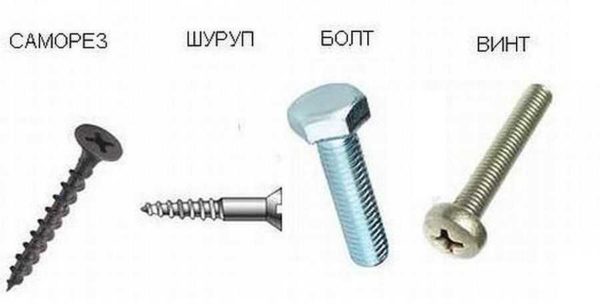
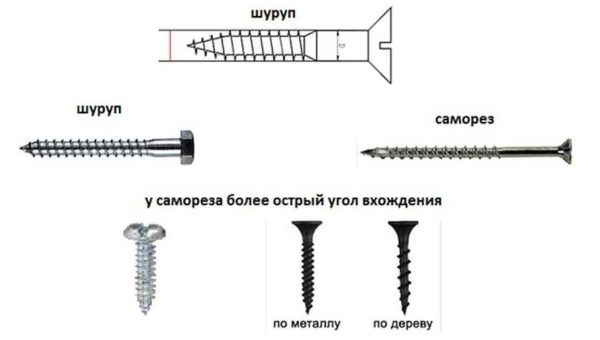
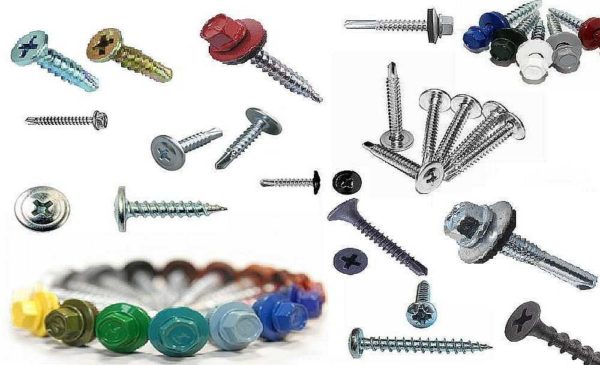
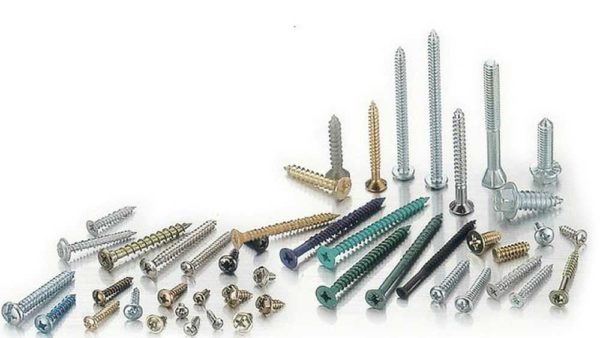
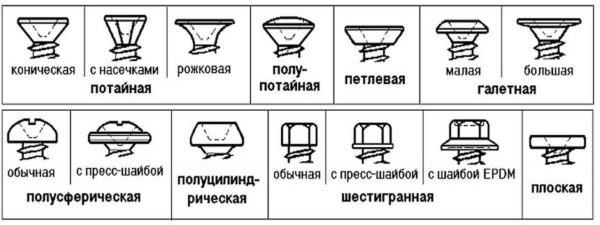
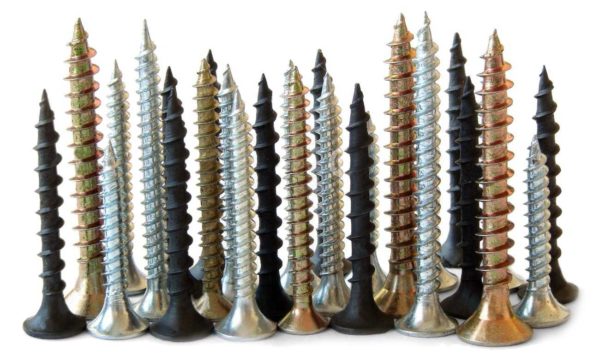
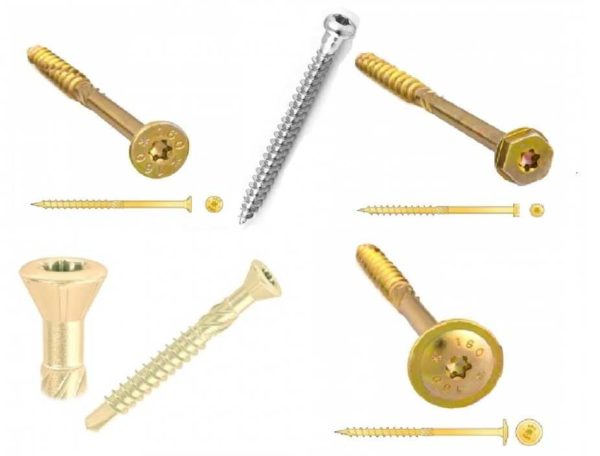
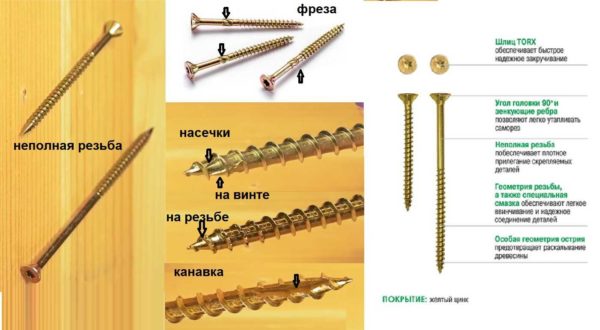
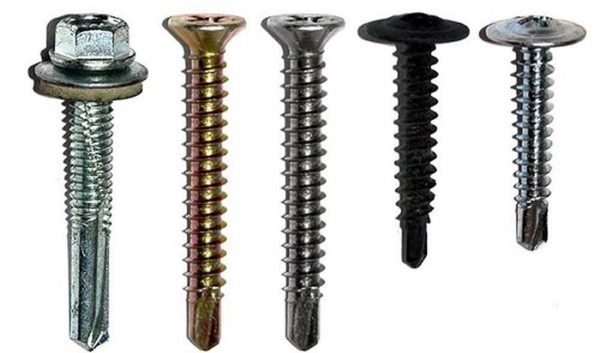
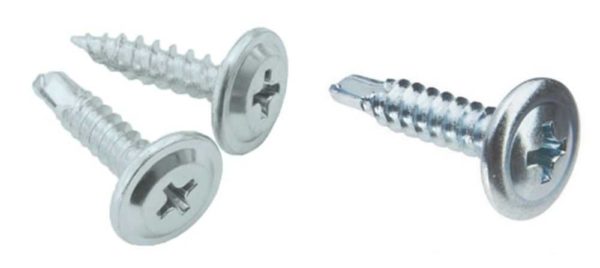

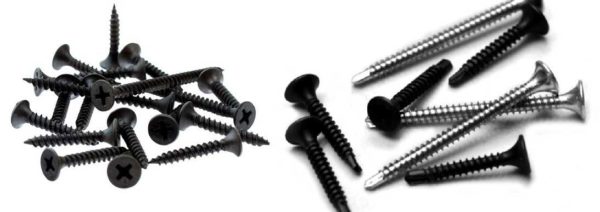
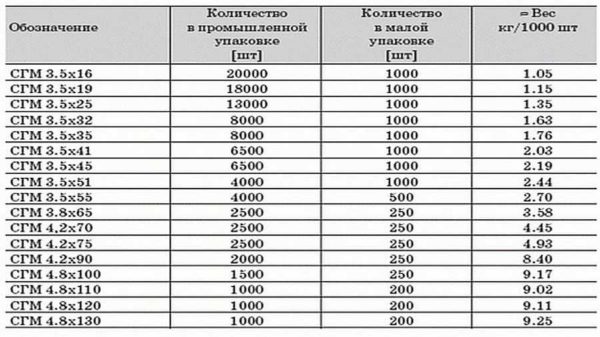
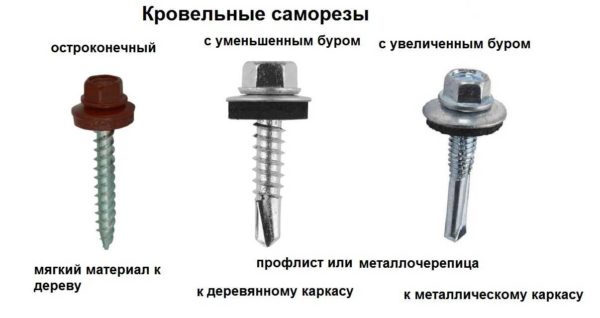










After 4 years of operation, I decided to disassemble the bench in the bathhouse (sink) and thoroughly pass it with Aquatex. Most of the screws were yellow zinc (Virtuoso), some black anodized. There is a crane on one side of the bench, i.e. humidity is higher. It was there that both galvanized and anodized self-tapping screws rusted and rotted. I wanted to buy with white galvanized, but 90 mm out of stock. I had to take the yellow ones again - I first dipped it in Aquatex and dried it, when I twisted it, I still lubricated it with machine oil. I don’t know if it’s worth it. Who uses what fasteners in saunas, such as long copper or brass screws?
For damp rooms use stainless steel hardware